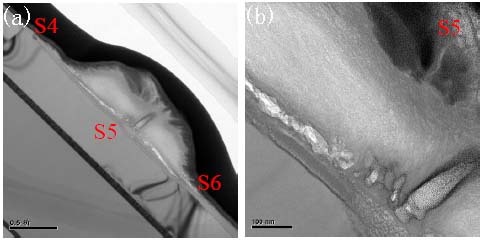=================================================================================
In IC devices, fluorine corrosion can be induced by F contamination as some F-based chemical gases and materials such as CF4, CHF3, SF6, HF, BOE (NH4F + HF) etc are used in microelectronics wafer fab. On the other hand, wafer shipment
package foam materials may also cause the F contamination and corrosion.
For instance, it is well-known that fluorine will often be detected near the surface of bondpads. This is because CF4 gas is used during bondpad opening fab process. Fluorine slightly reacts with Al and forms [AlFx](x-3)- (e.g. [AlF6]3-) or compounds AlxFyOz on the surface of bondpads. Unfortunately, these compounds cannot be cleaned away fully by EKC & DI water cleaning processes. Therefore, it is normal that some percentage of fluorine is detected on bondpads.
Table 2437. Bond-pad contamination in IC devices.
Contaminant |
Contamination sources |
Effects |
Fluorine |
Introduced through top metal etch or pad opening process, wafer packaging foam material, or shipping |
Induce non-sticking bond pad |
Fluorine can
react with Al to form F crystal: (NH4)3(AlF6) compound [1]; High fluorine contamination can induce thick native
oxide |
Chlorine |
Introduced through top
metal etch or pad etch process |
|
Carbon |
Introduced during the process of backside grinding, through
pad opening process [e.g. Figure 2437] |
Result in ball lift |
Oxygen |
Introduced during backside grinding process or pad opening process (e.g. formed AlxFyOz), by reactive epoxy diluents, or by package paper during shipping (e.g. containing Al, F, O, and K) [e.g. Figure 2437] |
|
Silicon dust |
Introduced during die sawing, by passivation residue due to under etch [e.g. Figure 2437] |
|
Kalium |
Introduced by package paper during shipping |
|
Figure 2437 shows an example of C, O, and Si contaminated bond pads. Area S6 had an abnormal film on the native Al oxide, while area S5 presented nonhomogeneous, loose and empty SixAlyCzOm materials in the hemispherical defect. These pad defects existed only at wafer edge because backside grinding was the root cause of the contamination.

Figure 2437. Contaminated bond pads. Adapted from [2]
[1] Y. N. Hua, S. Redkar, C. K. Lau, “A Study on Non-
Stick Aluminium Bondpads due to Fluorine
Contamination using SEM, EDX, TEM, IC, Auger, XPS
and TOF-SIMS Techniques,” Proceedings from the 28th
International Symposium for Testing and Failure
Analysis, Phoenix, Arizona, November, 2002, pp. 495-504.
[2] Paul Yu, Jamie Su, Qiang Gao, Ming Li, Chorng Niou, Study of Aluminum Pad Contamination Sources during Wafer Fabrication, Shipping, Storage and Assembly, International Symposium on High Density packaging and Microsystem Integration, 2007. HDP '07.
|
